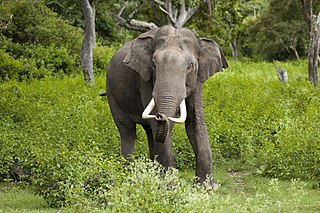
Elephantidae is a family of large, herbivorous mammals collectively called elephants and mammoths. These are terrestrial large mammals with a snout modified into a trunk and teeth modified into tusks. Most genera and species in the family are extinct. Only two genera, Loxodonta and Elephas, are living.
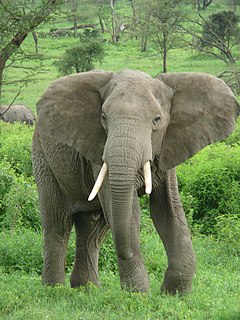
Paenungulata is a clade of "sub-ungulates", which groups three extant mammal orders: Proboscidea, Sirenia, and Hyracoidea (hyraxes). At least two more possible orders are known only as fossils, namely Embrithopoda and Desmostylia.

The rock hyrax, also called dassie, Cape hyrax, rock rabbit, and coney, is a medium-sized terrestrial mammal native to Africa and the Middle East. Commonly referred to in South Africa as the dassie, it is one of the five living species of the order Hyracoidea, and the only one in the genus Procavia. Rock hyraxes weigh 4–5 kg (8.8–11.0 lb) and have short ears and tail.

Verreaux's eagle is a large, mostly African, bird of prey. It is also called the black eagle, especially in Southern Africa, leading to potential confusion with the Indian black eagle, which lives far to the east in Asia. Verreaux's eagle lives in hilly and mountainous regions of southern and eastern Africa, and very locally in West Africa, the Arabian Peninsula and the southern Middle East. It is one of the most specialized species of accipitrid in the world, with its distribution and life history revolving around its favorite prey species, the rock hyraxes. When hyrax populations decline, the species have been shown to survive with mixed success on other prey, such as small antelopes, gamebirds, hares, monkeys and other assorted vertebrates. Despite a high degree of specialization, Verreaux's eagle has, from a conservation standpoint, been faring relatively well in historic times. One population of this species, in the Matobo Hills of Zimbabwe, is arguably the best studied eagle population in the world, having been subject to continuous detailed study since the late 1950s. Like all eagles, this species belongs to the taxonomic order Accipitriformes and the family Accipitridae, which may be referred to colloquially as accipitrids or raptors.

The dassie rat is an African rodent found among rocky outcroppings. It is the only living member of its genus, Petromus, and family, Petromuridae. The name "dassie" means "hyrax" in Afrikaans, and the two animals are found in similar habitats. Petromus means "rock mouse" and dassie rats are one of many rodents sometimes called rock rats. The family and genus names are sometimes misspelled as Petromyidae and Petromys.
Gryponyx is an extinct genus of massopod sauropodomorph known from southern Free State, central South Africa.
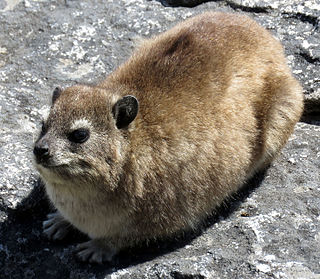
Procavia is a genus of hyrax. The rock hyrax (Procavia capensis) is currently the only extant species belonging to this genus, though other species were recognized in the past, including Procavia habessinica and P. ruficeps, both now relegated to subspecific rank.

Hyracodon is an extinct genus of mammal.

Hyrax Hill is a prehistoric site near Nakuru in the Rift Valley province of Kenya. It is a rocky spur roughly half a kilometer in length, with an elevation of 1,900 meters above sea level at its summit. The site was first discovered in 1926 by Louis Leakey during excavations at the nearby Nakuru Burial Site, and Mary Leakey conducted the first major excavations between 1937 and 1938. There are two distinct areas of occupation at Hyrax Hill: one which was occupied during the Pastoral Neolithic and late Iron Age, and one which was occupied by the Sirikwa earlier in the Iron Age.

The white-starred robin is a species of bird in the Old World flycatcher and chat family Muscicapidae. It is also sometimes more simply called the starred robin. It is monotypic within the genus Pogonocichla. There are around twelve subspecies. The species is found in East and southern Africa. It is a forest species, occurring in montane forest in the north of its range but closer to sea level further south. This is a brightly coloured robin with a bright yellow breast and belly, a slate coloured head with spots on the eyes and throat and blueish wings.
The rock dormouse or flat-headed African dormouse is a species of rodent in the family Gliridae. It is found in Botswana, Mozambique, South Africa, Eswatini, Zambia, and Zimbabwe where it lives among rocks in upland areas. It is a fairly common, mainly nocturnal species and the International Union for Conservation of Nature has assessed its conservation status as being of "least concern".
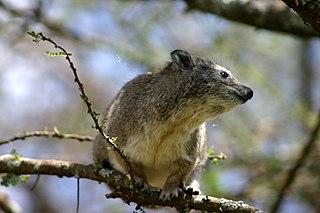
The southern tree hyrax or also known as the southern tree dassie is a species of mammal in the family Procaviidae. The southern tree hyrax is mainly found in the south central eastern side of Africa.

The tree hyrax or tree dassie is a small nocturnal mammal native to Africa. Distantly related to elephants and sea cows, it comprises the four species in the genus Dendrohyrax, one of only two genera in the family Procaviidae, which is the only living family within the order Hyracoidea.

The western tree hyrax, also called the western tree dassie or Beecroft's tree hyrax, is a species of tree hyrax within the family Procaviidae. It can be distinguished from other hyraxes by short coarse fur, presence of white patch of fur beneath the chin, lack of hair on the rostrum, and lower crowns of the cheek teeth compared to other members of the same genus.

The yellow-spotted rock hyrax or bush hyrax is a species of mammal in the family Procaviidae. It is found in Angola, Botswana, Burundi, the Democratic Republic of the Congo, southern Egypt, Eritrea, Ethiopia, Kenya, Malawi, Mozambique, Rwanda, Somalia, northern South Africa, South Sudan, Sudan, Tanzania, Uganda, Zambia, and Zimbabwe. Its natural habitats are dry savanna and rocky areas. Hyrax comes from the Greek word ὕραξ, or shrew-mouse.
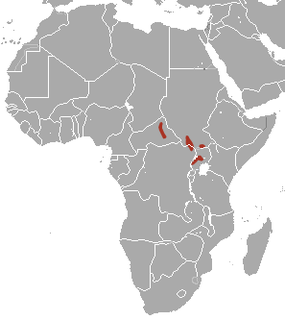
The Bunyoro rabbit or Central African rabbit is a species of mammal in the family Leporidae. It is monotypic within the genus Poelagus. It is found in central Africa and its typical habitat is damp savannah, often with rocky outcrops.
Metaschizotherium is an extinct genus that belongs to the family Chalicotheriidae, which was a group of herbivorous perissodactyl ("odd-toed") mammals. Though found primarily in Europe, fragmentary remains suggest that their range extended into Asia.
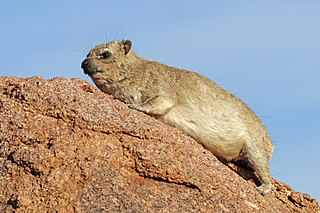
Hyraxes, also called dassies, are small, thickset, herbivorous mammals in the order Hyracoidea. Hyraxes are well-furred, rotund animals with short tails. Typically, they measure between 30 and 70 cm long and weigh between 2 and 5 kg. They are superficially similar to pikas and marmots, but are more closely related to elephants and sea cows.













